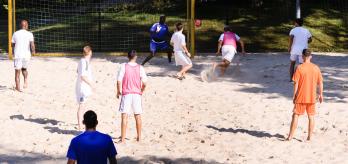Organisation
-
The exercise requires 8 outfield players (4 attackers, 4 defenders) and 2 goalkeepers.
-
Use the full pitch and both goals.
-
Set up 2 ball sources, one next to each goalkeeper.
-
Divide the players into two teams of 4 and a goalkeeper. Place 3 outfield players on the edge of the penalty area occupied by the goalkeeper starting the move and the fourth player on the edge of the opposing penalty area. Ask the opposing team to man‑mark the players looking to receive the ball (as per the graphic).
Explanation
-
The coach begins by explaining how players can lose their markers to receive the ball, by using various movements (changes of direction, decoy runs, feints, etc.) to get in front of their opponent or in behind.
-
The players being man‑marked then take it in turns to try to lose their marker in order to create the space to receive the ball from the goalkeeper.
-
The players should vary their runs and show for the ball in different areas.
Variations
-
This time, the aim is to create space for a team‑mate. Work on different types of marking and different marking systems (2 or 3 players involved, open up the middle of the pitch or the channels, etc.). Make sure the two teams take turns. Analytical work. No shooting allowed.
- The team in possession line up in a 1‑2‑2 formation. The exercise begins with a long throw‑out from the goalkeeper to an attacker. One of the attackers tries to lose their marker, while the other attacker takes up the space created by their team‑mate. The goalkeeper has the option of playing with either of the 2 attackers. Play continues as normal from the goalkeeper’s long throw‑out.
Coaching points
-
Encourage players to feint, make decoy runs and check their runs.
-
The players should seek different ways of losing their marker.
-
The coach can also ask the players questions to help them identify the space they need to create and the space created.































